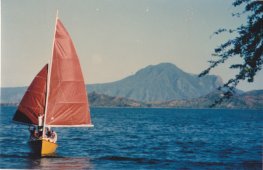Magayon: The Idea
When staying in the Philippines the first time in 1990 we joined an activity which involved moving a small sailboat from Taal lake to Puerto Galera. It went terribly wrong and the boat was lost. We then decided to build our own boat.
See also: Magayon in Indonesia
Setting the Scene: The “Infamous Boat”
During a short assignment to the International Rice Research Institute (IRRI) we joined a group of IRRI scientists, who jointly owned a boat that was moored in Lake Taal. We had the pleasure to join a sailing weekend on the boat but it was in poor condition with dry rot in many places of the hull. That is why the owners decided to get it out of the lake and transfer it to Puerto Galera on the neigboring island Mindoro, where several boat yards were located. The idea was to get it fixed there.

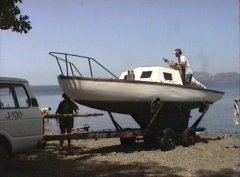
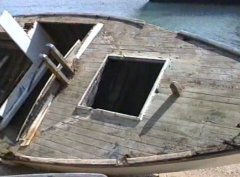
We joined the group who moved the boat. Unfortunately everything that could go wrong went wrong. During the lowering of the mast John broke through the front hatch. When the boat was on the trailer one of the wheels of the trailer fell off. Once that was fixed and we started to tow the trailer the hitch at the old Toyota Landcruiser broke and it took Saturday night to find a replacement and mount it to the car. The next day the boat was succesfully launched in Batangas, a bangka (outrigger boat) was hired to tow the boat to Puerto Galera and Marhz and Boru went off in tow. During the crossing of Batangas channel wave came on board and flooded the boat through the front hatch. It was in danger of sinking but made it to Puerto Galera with Boru and Marhz bailing water for sheer survival. The boat was then anchored at one of the boat yards. However, the next morning it had disappered. It just sunk. After raising it the specialist advise of the boatyard was to scrap the boat because of the amount of damage and because the Philippien boatyards are used to work with plywood and are not familiar with the way the boat was built using wood strips. In one of this sad moments of life we stripped the boat of all still usable partes and then left it at the boatyard as junk.
The Plan
For the next years or so we moved into a big house with an even bigger garden in Los Banos. We soon met Ken, who introduced us to his project of building a Norwalk Island Sharpie. He had employed Ralfi, a local carpenter for the job. Ralfi had done some repair at another boat before. At that stage the hull of Ken’s boat, which was built upside down, had just been turned. It did not take long to decide to politely turn down Kens offer to join his building exercise and to decide to get a second boat built. Two boats of the same type promised to be lots of fun. Ken offered to share Ralfis time and provided the contacts to the boat designer Bruce Kirby in the US and to Duck Flat Wooden Boats in Australia who were popularizing the boats Down Under. We immediately purchased a second set of plans.
The Boat
The Norwalk Island Sharpies were designed by Bruce Kirby based on the traditional sharpies. They are fast, easy to sail and their flat bottom and centerboard makes them highly suitable for trailoring and for sailing in the coastal waters of the Philippines where plenty of corral reefs reach close to the surface.
Specifications of the NIS23:
| British | SI units | |
| LOA: | 22’11″ | 7 m |
| DWL: | 19’0″ | 5.8 m |
| Beam: | 7’3″ | 2.9 m |
| Draft: Centerboard up: Centerboard down: | 8″ 4’7″ | 0.2 m 1.4 m |
| Displacement without crew: | 1,800 lbs | 816 kg |
| Sail areas: Main Mizzen Total: | 160 sqr. ft 56 sqr.ft. 216 spr.ft. | 14.87 m2 5.2 m2 20.06 m2 |
| Balast lead: | 600 lbs | 272 kg |
Building Magayon
Building was an adventure. After the first boat was built in the garage at Ken’s place Ralfi wanted to build the second one at his house. We hoped to have the main work done before the beginning of the rainy season, so we did not think that this would be a problem. A building contract was drafted with Ralfi getting a certain percentage of the material value as lumbsum for his work.
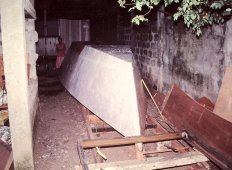
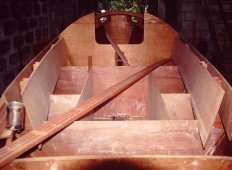

Work progressed quickly and the hull took shape, still upside down. It was coated with resin and fiberglass before it was turned over for completion.
Unfortunately the weather gods were not with us and it rained cats and dogs one day leaving 1 foot of water inside the hull. Work was practically stopped until the wood had dried out again. Other factors such as waiting for parts like the rigs, that had to be imported from Australia, slowed down the process. During idle time Ralfi and some friends, who owned a welding set, built a trailor from scrap and second hand automotive parts. Officers at the German TV would dy of instant shock if they would see the trailer, but it served its purpose and nobody seems to care in the Philippines about the condition of vehicles. A winch and other parts were bought in Germay during our home leave. When visiting California we bought the ropes and a lot of second hand parts.
Finally, after almost one year the boat got it’s final paint and was ready for launching.
How much did it cost?
After talking ot Ralfi and calculating the cost of import of the rig and other fittings the first estimate was around DM 15,000.-. However building took longer and some additional expenses were needed, a trailor had to be built. When Ralfi handed over the boat to us the total amount spent was DM 21,018.- including the trailer. Not too bad I assume.
Table 2: Total cost of building Magayon
| Cost item | Price in 1994 |
| Trailer | 830.00 |
| Labor | 2731.07 |
| Interior | 431.57 |
| Fees | 556.14 |
| Rig | 7741.28 |
| Hull | 7990.60 |
| Electric system | 117.88 |
| Fittings | 177.20 |
| Others | 443.05 |
| Total | 21018.79 |

Launching
First thing was to find a name for the boat. Ken called his boat Maria Makiling after the legendary godess Maria Makiling, who fell in love with a mortal and was punished by the gods by being converted into mount Makiling. In analogy we decided to call our boat Magayon after the legend around the famous vulcano Mayon in Bicol.
Second thing was to get the boat out of Ralfi’s driveway. This proved to be more difficult than expected because the gate was about 5cm too narrow. There was no other way, Ralfi had to tear part of his wall down.
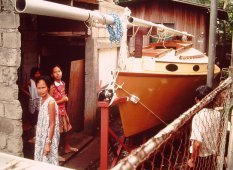


The trip to Lake Caliraya went surprisingly well given the fact that the trailor had never been used before. Launching was supposed to happen at Caliraya Surf Camp and anticipating problems we brought tents, food and supplies for a couple of days.

The Launch
Getting Magayon off the trailor into the water went almost too smooth. The following baptism needed several attempts of Mavic smashing the plastic bottle filled with champaign in which we had carved default break lines. It just did not want to break. Finally it did break and launching could move ahead. After rigging and some fine tuning of the rig Magayon was ready for her maiden voyage.The crew consisting of Boru, Martin and Marhz boarded and off they went. A bit wimpy in the beginning with both sails reefed she sailed beautifully – until the rudder hinges broke two hours later. With Boru hanging out at the back and holding the rudder we made it back to the shore. Despite the little problem with the hinge we were greatly satisfied with the performance of Magayon and packed her up for going home.
The following pictures are not from the maiden voyage but from anohter weekend with Rik and Helmut as crew.


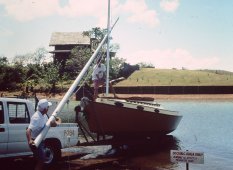
halyard








Sailing Magayon
Rigging is easy and using a method suggested by Duck Flat Wooden Boats it can be done by a single person. It does not take more than an hour even under unfavourable conditions to get her in the water.
She sails very fast, both on and off the wind and with the wind anywhere she self-steers great with proper trim of the sails. Because both sails are boomed and supported by lazy jacks handling could not be easier.
The draft of only 0.2m with the centerboard up makes the boat ideally suited for accessing shallow beaches and cruising in tropical waters with plenty of corral reefs .
Lake Caliraya
The man made Caliraya lake is located in the mountains south of Laguna lake. It provides the water for a hydropower plant and used to be a tropical paradise with little development because construction was restricted. Windsurfers from Manila used to come during the weekend for practice and some racing. Recently the lake’s shore has been developed with some resorts and jet skis have entered the once so quiet place. Nevertheless it is still a fine destinaton for a weekend trip starting from Manila or Los Banos.



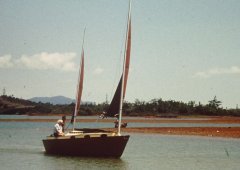
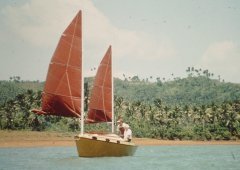


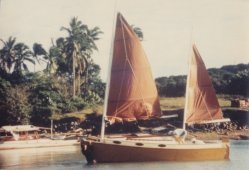
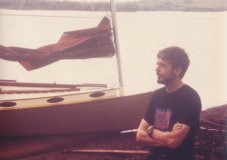
Winds are usually blowing most times of the year with forces between 2 and 4. Because of it’s altitute expect to have more rains than in Manila.
Lake Taal
During weekend expeditions to Talisai at Taal Lake we finally met R., a German married to a Philippina from Bicol. They were jointly running the resort “Milos Paradise” in Talisay and were very supportive to all kinds of water sports. And – they had something that with some goodwill one could call a ramp. The next couple of times we took the boat on very bad roads to Milos Paradise and launched there. We had some great sails, which included one race with Ken and his crew around the vulcano island which took much longer than expected because the wind dropped. In exchange for some drinks from our cooler we finally got a tow from Ken’s boat because at that time Magayon did not have a motor yet. Until now the opinions, who actually won the race, differenciate
Unfortunately R. ran into problems with the previous owner and with the local police and succedingly he was shot in the throat. A year later or so he sold the place. Meanwhile Taal Yacht Club had started operation so we moved both boats over there.
Magayon finally got Ken’s old seagull motor built in the early 60ies with 6hp which made sailing a bit more convenient. However we first had to replace the ignition cable and finding the information for stetting the timing was a bit of a problem. The solution was finally found in the Internet and from then on we did not need to be towed anymore.
With the initial problems of both boats sorted out we then had some great weekends with typical Taal wind conditions (gusty during the day with stronger winds in the late afternoon) and sailed into some great sunsets. We had both boats out several times which was great fun.
The boats attracted some attention of helpful fishermen who wanted to bring back the boyes thrown overboard for men-over-board manuevers. Motor bangkas (boats) had to be continously observed because their skippers did not have a clue about rules on water. One weekend a helicopter pilot found Magayon so interesting that he came down so close that we almost got in trouble.
Anilao
After getting confident on the lakes we finally wanted to get some experience on the sea. Magayon therefore was moved to Anilao. Launching was an adventure on a public beach with very soft sand but with the help of hundreds of local spectators we finally got her in the water.
In rough sea and wind force 4 she proved suitable for coastal sailing as well.
Moving on
In July 1997 Martin’s application for a job in Indonesia was approved so after a last sail we transferred the boat back to Los Banos where it was temporarily stored at Ken’s house. Unfortunately there is not much of a market for sailing boats in the Philippines, therefore we shipped Magayon together with our personal effects in a 40′ container to Ujung Pandang in South Sulawesi, Indonesia.
Makassar (formerly Ujung Pandang)
See separate page for sailing in Indonesia
Crews
Thanks for the good time to the following Magayon crew members who joined on one or more trips:
- Andrea, Bengt, Bettina, Bill, Boru, Brigitte, Chris, Christian, Claus, Edith, Gigi, Helmut, Klaus, Mavic, Mahrz, Miki, Joven, John, Kath, Kite, Mathias, Rik, Riza and her brother, Sophie, Uli, Wet Wet, and others.
- Thanks to Klaus and Bettina for transferring the boat across the Taal lake and congratulations for surviving their first big test for the trip around the world.
- Thanks to Ken and Sue for their patience when Magayon was stored at their place for longer than expected.
- Thanks to Robert Ayliffe from Duck Flat Wooden Boats in Australia who arranged for the purchase of the rig and for shipping the stuff.
- Thanks to various people at Caliraya surf camp who helped stopping the boat and car when both started sliding backwards into the water.
- Thanks also for the crews of Maria Makiling: Skipper Ken, Boru, Chris, Kath, Ralfi and friends, Sophie, and more
- Thanks to the many Filipinos who helped us at various beaches with launching.
- And last not least thanks to Ralfi and his friend for building the boat, repairing and joining plenty of trips on Maria Maliling.
- I almost forgot: Thanks to Michael (Dr. No) for not allowing us to temporarily store the boat at the Institute.
